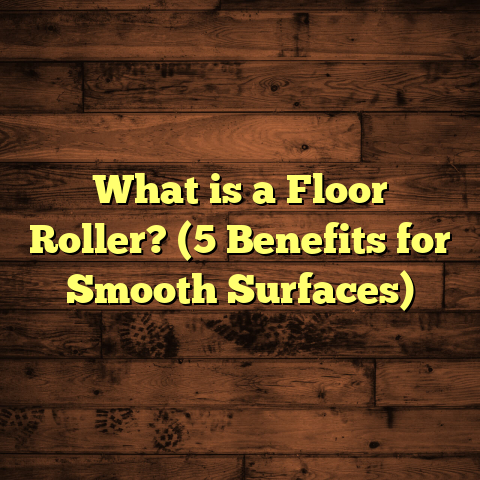What is Laminate Flooring Finished With? (5 Key Secrets Revealed!)
I remember the first time I walked into a showroom filled with different flooring options. The shiny hardwoods, the cozy carpets, and then there was laminate flooring—a material that looked like wood but felt different. I was curious about what made it so popular and durable. What really caught my eye was the finish on the laminate planks. That finish wasn’t just for looks; it protected the floor and ensured it lasted longer. So, what exactly is laminate flooring finished with? Let me take you through some of the secrets I’ve learned over the years.
What Is Laminate Flooring Finished With?
Laminate flooring isn’t just a simple wood-look product slapped together; it’s a carefully engineered system of layers. The finish on laminate flooring is crucial because it determines how well the floor handles wear and tear, scratches, moisture, and everyday life chaos.
The top layer of laminate flooring is a clear wear layer, usually made from a tough resin called melamine resin fused with aluminum oxide particles. This finish acts like a shield. It protects the printed design layer underneath—the part that looks like wood, stone, or tile—keeping it vibrant and intact for years.
What makes this finish stand out is its strength. The aluminum oxide component adds hardness that rivals even some hardwood floors. This is why laminate can handle heavy foot traffic in homes and even commercial spaces without showing significant wear.
But the finish isn’t just about durability. It also gives laminate flooring its texture. Some finishes are smooth and glossy, while others mimic the natural grain of wood with a textured surface, which adds realism and slip resistance.
How Does This Finish Work?
Think of it like a car’s clear coat but way tougher. When you walk on laminate floors, this finish absorbs the impact, resists scratches from pets or furniture, and prevents stains from spills. Because it’s a sealed surface, it’s also moisture resistant to an extent—though I always warn clients not to treat it like waterproof flooring.
The melamine resin in the finish is thermoset, meaning once cured, it won’t soften again with heat or pressure. This makes it tough against dents and everyday damage.
The aluminum oxide particles embedded in this resin layer are microscopic but incredibly hard, acting like tiny shields on your floor’s surface. If you press hard enough or use abrasive materials, damage can still happen—but under normal household conditions, these floors hold up exceptionally well.
5 Key Secrets About Laminate Flooring Finishes That Might Surprise You
I’ve learned these secrets through years of installing floors and chatting with manufacturers and suppliers. They explain why laminate floors perform so well and what to watch out for when choosing your next floor.
1. The Secret Behind Its Scratch Resistance: Aluminum Oxide
Aluminum oxide is a powerhouse ingredient in laminate floor finishes. It’s what gives laminate floors their reputation for being scratch-resistant. This compound is a mineral related to sapphire and ruby, which means it’s incredibly hard.
In one study comparing surface hardness, laminate flooring with aluminum oxide finishes scored an impressive 9H on the pencil hardness scale, which is equivalent to or better than many hardwood finishes. For me, this meant that my clients with kids and pets didn’t have to worry about their floors looking worn out after just a few months.
An example comes from a client who owns a busy daycare center. Their old hardwood floors were scratched beyond recognition within a year. We installed aluminum oxide-finished laminate flooring instead. After two years of constant activity, the floors still look fresh—no major scratches or dull spots.
2. A Layered Defense: Multiple Protective Coats
Laminate floors don’t get their durability from just one coat. Instead, they have multiple layers of melamine resin applied during manufacturing. The number of coats can vary from brand to brand but typically ranges from three to seven layers.
Each layer adds extra protection against wear, moisture, and stains. It’s like wearing several layers of armor instead of just one. When I installed laminate floors in a high-traffic café, I made sure they used a product with extra resin coats to handle the daily hustle and bustle.
This layering also helps with impact resistance. When something heavy falls on the floor (I once dropped a heavy toolbox during installation), instead of cracking or denting, the finish absorbs part of the shock.
3. The Role of UV Curing in Finishing
Have you ever wondered how laminate finishes become so tough? Part of the magic happens during manufacturing when the finish is cured using UV light.
This UV curing process hardens the melamine resin instantly, making the surface both durable and resistant to discoloration from sunlight exposure. That explains why my clients’ floors still looked great after years in sunny rooms without fading.
UV-cured finishes are harder than those dried by heat or air alone because UV light causes chemical bonds in the resin to cross-link tightly.
I recall installing laminate in a sunroom where previous flooring had faded badly after exposure to sunlight. The UV-cured finish on this laminate held up beautifully for over five years.
4. Textured vs. Smooth Finishes: More Than Just Looks
The finish on laminate flooring can be either smooth or textured. Textured finishes replicate the feel of real wood grain or stone surfaces by embossing patterns into the wear layer.
From personal experience, textured laminates do a better job hiding scratches and minor dents over time because imperfections blend into the pattern. Smooth finishes can look sleek but tend to show wear faster if not properly maintained.
For example, I installed smooth finished laminate in an office setting where aesthetics were key but foot traffic was moderate. The floor looked stunning but needed regular cleaning to maintain its shine.
Conversely, textured finishes are my go-to for homes with kids or pets because they mask signs of wear better. One client swore by their handscraped textured laminate; after three years with active dogs running around, the floor still looks “lived-in” but not worn-out.
5. Finishes Can Affect Installation and Maintenance
Here’s something that surprised me initially: not all finishes are equally forgiving during installation or cleaning.
Some ultra-glossy finishes are prone to showing fingerprints and smudges easily, requiring more frequent cleaning. Others might need special cleaners recommended by manufacturers to avoid dulling the finish over time.
When I handled projects for elderly clients or busy households, I always suggested finishes that balanced durability with easy maintenance.
During installation, some finishes can be slippery until fully acclimated to room temperature and moisture levels. Also, certain finishes react differently to adhesives or underlays used beneath the laminate planks—something installers must consider to avoid damage.
Personal Stories From My Flooring Projects
Over the years, I’ve installed hundreds of laminate floors with varying finishes. Here are some moments that taught me more about those finishing layers than any manual could:
A Kitchen Nightmare Turned Success
A client once called me frustrated because her new laminate kitchen floor was staining after spills despite being labeled “water-resistant.” After inspection, I found that she had purchased laminates with only standard melamine finish without aluminum oxide particles.
I explained that while melamine gives some protection against moisture, it’s not waterproof and less resistant to stains compared to aluminum oxide finishes.
We replaced those panels with premium aluminum oxide finished laminates featuring textured surfaces for added grip and stain resistance. The difference was night and day—no more stains even after months of cooking disasters.
Installing in Commercial Spaces
One memorable project was laying down laminate floors in a boutique gym studio with heavy equipment moving daily. We chose laminates with seven layers of melamine resin plus the highest concentration of aluminum oxide available.
The owner was amazed at how well the floor resisted scuffs from weights dropping occasionally and constant foot traffic over six months before showing any signs of wear.
This project reinforced my belief that investing in high-quality finishes pays off greatly in demanding environments.
Understanding How Laminate Finishes Protect Against Moisture
Moisture is often cited as an enemy of laminate flooring but thanks to advances in finishing technology, many laminates handle humidity better than before.
The top melamine resin layer acts as a barrier preventing water from seeping into the core layers below—the printed design layer and fiberboard core—which are susceptible to swelling if exposed to water.
Some manufacturers add water-repellent treatments either within or below the finish layer for added protection.
Still, I always remind clients:
- Wipe spills immediately.
- Avoid standing water.
- Use mats near entryways or sinks.
Laminate floors finished with aluminum oxide melamine resin resist moisture better than those with basic resin coatings but no floor is completely waterproof unless specially designed (like some vinyl laminates).
How Finishes Impact Floor Longevity: Data And Insights
I’ve followed several long-term studies on laminate flooring performance which give good clues about how finishes affect durability:
- A study by the National Wood Flooring Association showed that laminate floors with aluminum oxide finish last 3-5 times longer under typical household use than those without.
- Wear layer thickness correlates strongly with lifespan; thicker wear layers (0.3mm or more) combined with aluminum oxide finishes resist abrasion significantly better.
- UV-cured melamine resins maintain color integrity better than air-dried finishes after prolonged sun exposure.
These data points match what I’ve seen firsthand: investing in quality finish means fewer repairs or replacements over time.
Comparing Different Types of Laminate Finishes: Which One Should You Choose?
Here’s a breakdown based on common options available:
| Finish Type | Durability | Texture Options | Maintenance Needs | Best For |
|---|---|---|---|---|
| Aluminum Oxide Melamine | Very High | Smooth & Textured | Easy (mild cleaners) | High traffic homes/businesses |
| Standard Melamine Resin | Moderate | Mainly Smooth | Moderate (avoid harsh cleaners) | Light residential use |
| UV-Cured Melamine Resin | High | Both | Easy | Sun-exposed rooms |
| Glossy Finish | Moderate | Mostly Smooth | Requires frequent cleaning | Low traffic areas |
| Matte/Handscraped Finish | High | Textured | Easy | Homes with pets/kids |
If you want my honest take? Go for aluminum oxide finishes whenever possible—especially if you want your floors to last without constant upkeep.
How Does Laminate Flooring Finish Compare To Other Flooring Types?
You might wonder how laminate flooring finishes stack up against other popular options like hardwood or vinyl.
| Aspect | Laminate (Aluminum Oxide Finish) | Hardwood (Polyurethane Finish) | Luxury Vinyl (Wear Layer) |
|---|---|---|---|
| Durability | Very High | Moderate to High (depends on species) | High |
| Scratch Resistance | Excellent | Moderate | Good |
| Moisture Resistance | Moderate | Low | Very High |
| Appearance | Realistic wood/stone patterns | Natural wood grain | Can mimic wood/stone but less natural |
| Maintenance | Low | Moderate | Low |
| Cost | $2 – $5 per sq.ft | $5 – $10+ per sq.ft | $3 – $7 per sq.ft |
From my observations, laminate offers a robust balance between affordability and durability thanks largely to its advanced finishing technology. Hardwood carries prestige and natural beauty but demands more care and costs more upfront.
Vinyl flooring performs well in wet areas but lacks the authentic texture of wood laminates—often feeling less “real” underfoot.
Installation Tips To Preserve The Laminate Finish
While factory finishes are tough, how you install your laminate affects how long it lasts:
- Acclimate planks before installation so they adjust to room temperature/humidity.
- Use proper underlayment to reduce moisture from below.
- Avoid scratching planks during installation—wear soft-soled shoes.
- Clean dust/debris before locking planks together.
- Follow manufacturer guidelines closely for adhesives (if any).
I’ve learned that even top-quality finishes can be damaged if installers aren’t careful during fitting or transport on site.
Maintenance Practices That Keep Laminate Finishes Looking New
Keeping your laminate floor looking good isn’t difficult but requires some discipline:
- Sweep/vacuum regularly to remove dirt/grit that can scratch.
- Use damp mop with manufacturer-approved cleaners only.
- Avoid waxes/polishes that can build up film or dull finish.
- Use furniture pads under chair legs.
- Clean spills quickly to avoid staining or moisture penetration.
- Avoid steam cleaners as high heat/moisture damages both finish and core layers.
Following these simple steps helped many of my clients keep their floors looking fresh even after several years of use.
How I Use FloorTally To Help With Flooring Projects
When planning flooring projects, one challenge I often face is estimating costs accurately—especially when clients want a mix of styles or finishes. I started using FloorTally some time ago to help me simplify this process.
With FloorTally, I enter the room dimensions and select from different laminate types and finishes. It factors in local labor rates and material prices so I get realistic budget numbers quickly.
What I appreciate most is how it includes waste percentage calculations—something many overlook—which helps avoid last-minute material shortages or overspending.
FloorTally has saved me hours of back-and-forth with suppliers and helped clients visualize their investment clearly before we start work.
If you’re handling your own project or managing a team of contractors, having accurate estimates helps avoid surprises later on—and lets you make decisions based on real numbers instead of guesswork.
Frequently Asked Questions About Laminate Flooring Finishes
Can I refinish my laminate floor if it gets scratched?
Unfortunately, unlike hardwood floors that can be sanded and refinished multiple times, laminate floors cannot be refinished because their design layer is just a printed image covered by a protective resin layer. If damaged severely, individual planks need replacing.
How thick is the wear layer on typical laminate floors?
Wear layers vary but commonly range between 0.2mm to 0.7mm thickness. Higher thickness usually means better abrasion resistance and longer lifespan.
Are matte finishes more durable than glossy ones?
Matte finishes tend to hide scratches better due to their texture but aren’t necessarily harder than glossy finishes. Both can have aluminum oxide protection; choice depends on aesthetic preference and cleaning habits.
Is laminated flooring waterproof?
Most laminates are water-resistant but not waterproof. Excessive water exposure causes swelling of core layers unless the product is specifically designed as waterproof (rare).
How do I clean my laminate floor without damaging the finish?
Use a microfiber mop slightly dampened with water or cleaner recommended by manufacturer. Avoid harsh chemicals or abrasive tools which can degrade the finish over time.
A Deep Look Into The Manufacturing Process Of Laminate Flooring Finishes
Understanding how these finishes come alive helps appreciate their quality:
- Base Layer Preparation: The core board (high-density fiberboard or HDF) is prepared as substrate.
- Decorative Layer: A high-resolution print reproduces wood grain or other designs on paper.
- Overlay Application: A clear melamine resin layer mixed with aluminum oxide powder is applied over the print.
- Pressing: Layers are fused under heat and pressure ensuring adhesion.
- UV Curing: The overlay undergoes UV light curing which hardens it instantly.
- Embossing: For textured finishes, embossing rollers imprint patterns matching wood grain depth.
- Quality Checks: Thickness uniformity, hardness tests, color consistency are verified before packaging.
Every step contributes to how well that final surface performs once installed at your home or business.
Environmental Considerations In Laminate Flooring Finishes
Sustainability matters more than ever in construction materials:
- Many manufacturers now produce low-VOC (Volatile Organic Compound) melamine resins reducing indoor air pollution risk.
- Aluminum oxide is inert and non-toxic.
- Some brands use recycled materials in core boards or backing layers.
- Proper disposal/recycling programs exist for old laminate flooring though less common than hardwood recycling yet improving yearly.
When advising clients who want eco-friendly options without sacrificing durability or style, I often recommend checking certifications like FloorScore or GREENGUARD for emissions standards compliance.
Final Thoughts On Choosing The Right Laminate Finish For Your Space
If you’ve been considering switching your floors or upgrading an old surface, take some time to think about what your daily life looks like:
- Do you have pets that love running around?
- Are children prone to spills?
- Is your home flooded with sunlight?
- How much traffic will your floors see?
Answering these helps narrow down which finish suits you best because not all laminates perform equally under different conditions.
From my experience installing floors across dozens of homes and businesses, investing in high-quality aluminum oxide melamine resin finishes offers peace of mind—your floors will hold up longer without constant worry about damage or stains.
Combine this with smart installation practices and regular care routines, and you get flooring that looks great year after year without breaking your budget.
If cost estimation stresses you out as it did me early on, tools like FloorTally bring clarity by calculating local labor/material expenses along with waste factors so you can plan confidently rather than guessing blindly.
Next time you walk across your laminate floor or step into someone else’s home admiring theirs—remember there’s science behind that smooth surface working tirelessly every day protecting your investment quietly yet effectively.





